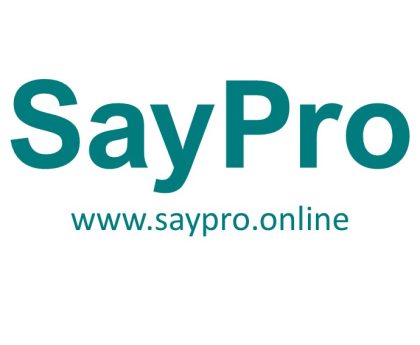SayPro Stock Management Analyze past sales trends to forecast upcoming demand, ensuring stock is sufficient from SayPro Monthly April SCMR-17 SayPro Monthly Inventory Management: Stock tracking, order fulfilment, and supplier management by SayPro Online Marketplace Office under SayPro Marketing Royalty SCMR
Objective
To develop a data-driven forecasting model using historical sales trends to anticipate future product demand. This allows SayPro to:
- Maintain optimal stock levels
- Prevent stockouts and overstocking
- Improve supplier coordination and order timing
- Support strategic decisions for promotions and marketing campaigns
📌 Importance of Demand Forecasting in Inventory Management
Demand forecasting allows SayPro to:
- Identify fast-moving and slow-moving products
- Plan stock replenishment based on actual data patterns
- Optimize warehouse space and cash flow
- Align marketing campaigns with inventory capacity
- Improve overall customer satisfaction by ensuring product availability
📊 Data Sources and Sales History Analyzed
The following datasets are reviewed monthly as part of SCMR-17 reporting:
| Data Source | Description |
|---|---|
| Sales Records | Weekly, monthly, and quarterly sales by SKU, category, region |
| Order Logs | Successful, canceled, returned, and backordered items |
| Platform Analytics | Product page visits, cart abandonment rates, conversion rates |
| Promotional Campaign Data | Sales spikes or dips linked to specific marketing efforts |
| Customer Feedback & Reviews | Product availability concerns and demand cues |
For April 2025, analysis was based on:
- Sales data from January to March 2025
- Seasonal trends from April 2024
- Product category movement during Q1 2025
🔍 Methodology for Trend Analysis and Forecasting
Step 1: Data Collection & Consolidation
- Extract sales data from SayPro’s inventory management system (IMS) and e-commerce analytics dashboard.
- Clean and consolidate data by SKU, product category, region, and timeframe.
Step 2: Identify Sales Patterns
- Look for monthly demand cycles, day-of-week variations, and seasonal trends.
- Highlight:
- Top-performing SKUs
- Frequently stocked-out items
- Low-demand or stagnant inventory
Step 3: Trend Projection
- Apply moving average and year-on-year comparison techniques.
- Use predictive analytics tools or Excel models to:
- Estimate upcoming demand for the next 4–8 weeks
- Calculate average lead times for replenishment
- Define reorder points based on projected usage
Step 4: Stock Adjustment Planning
- Compare forecasted demand against current stock levels.
- Identify:
- Products needing urgent replenishment
- Items at risk of overstocking
- Opportunities for product bundling or clearance sales
Step 5: Supplier Alignment
- Share demand forecasts with key suppliers.
- Adjust purchase orders to align with expected demand.
- Plan safety stock buffers based on forecast accuracy from previous months.
📈 Forecasting Insights – April 2025 Example
| Product Category | Q1 2025 Avg. Monthly Sales | Forecasted Demand (May 2025) | Stock Status | Action Needed |
|---|---|---|---|---|
| Eco Kitchen Sets | 320 units | 410 units | 250 units in stock | Reorder 200 units |
| Organic Body Wash | 190 units | 205 units | 300 units in stock | Delay reorder |
| Bluetooth Earbuds | 550 units | 580 units | 570 units in stock | Reorder 100 units |
| Children’s Books | 160 units | 140 units | 190 units in stock | Promotion/clearance |
📎 Key Metrics Used
| Metric | Description |
|---|---|
| Sell-through Rate | Measures how fast inventory is sold in a given period |
| Inventory Turnover | Indicates how often inventory is sold and replaced |
| Days of Inventory on Hand (DOH) | Predicts how long current stock will last |
| Reorder Point (ROP) | Triggers when stock falls below safe minimum levels |
| Forecast Accuracy | Assesses the precision of previous demand predictions |
📋 Reporting and Decision-Making
- Weekly Forecast Reports submitted to the SCMR-17 digital system.
- Insights used for:
- Stock replenishment scheduling
- Supplier purchase planning
- Inventory control improvement plans
- Strategic marketing coordination
✅ Benefits of Forecasting-Based Stock Management
- Reduced inventory carrying costs
- Higher order fulfillment rates
- Improved customer satisfaction due to stock reliability
- Data-informed procurement decisions
- Stronger supplier relationships through proactive planning
🛠 Tools and Resources Utilized
- SayPro Inventory Management System (IMS)
- SayPro Online Marketplace Analytics
- Microsoft Excel Forecast Templates
- Optional: Integration with Power BI or Google Data Studio for visual trend tracking



